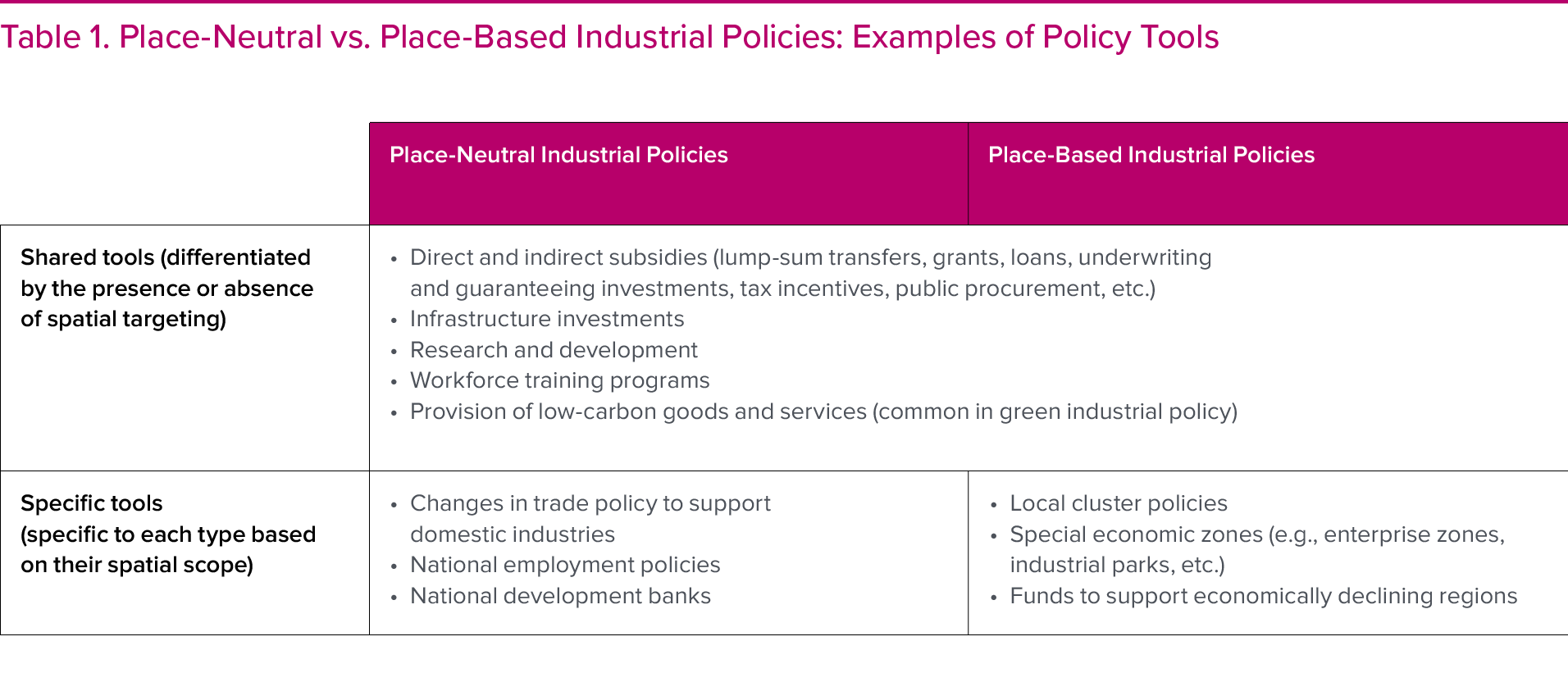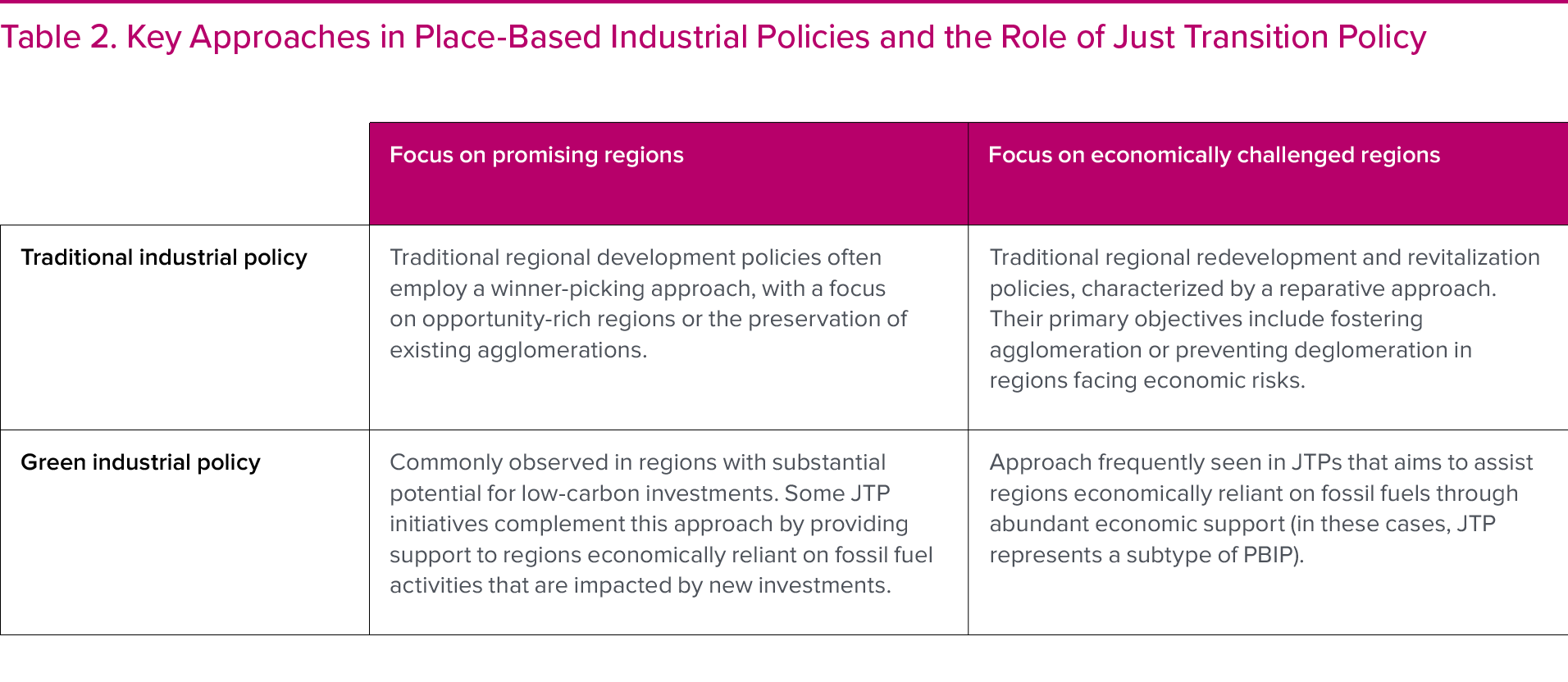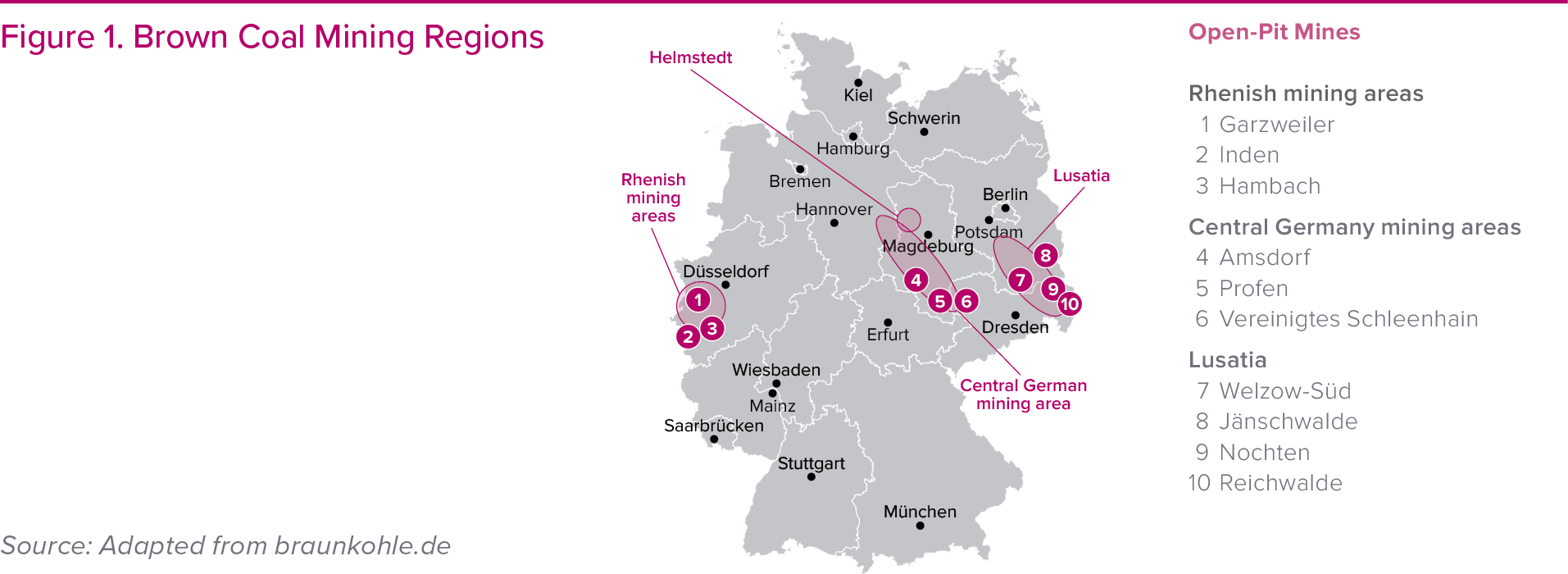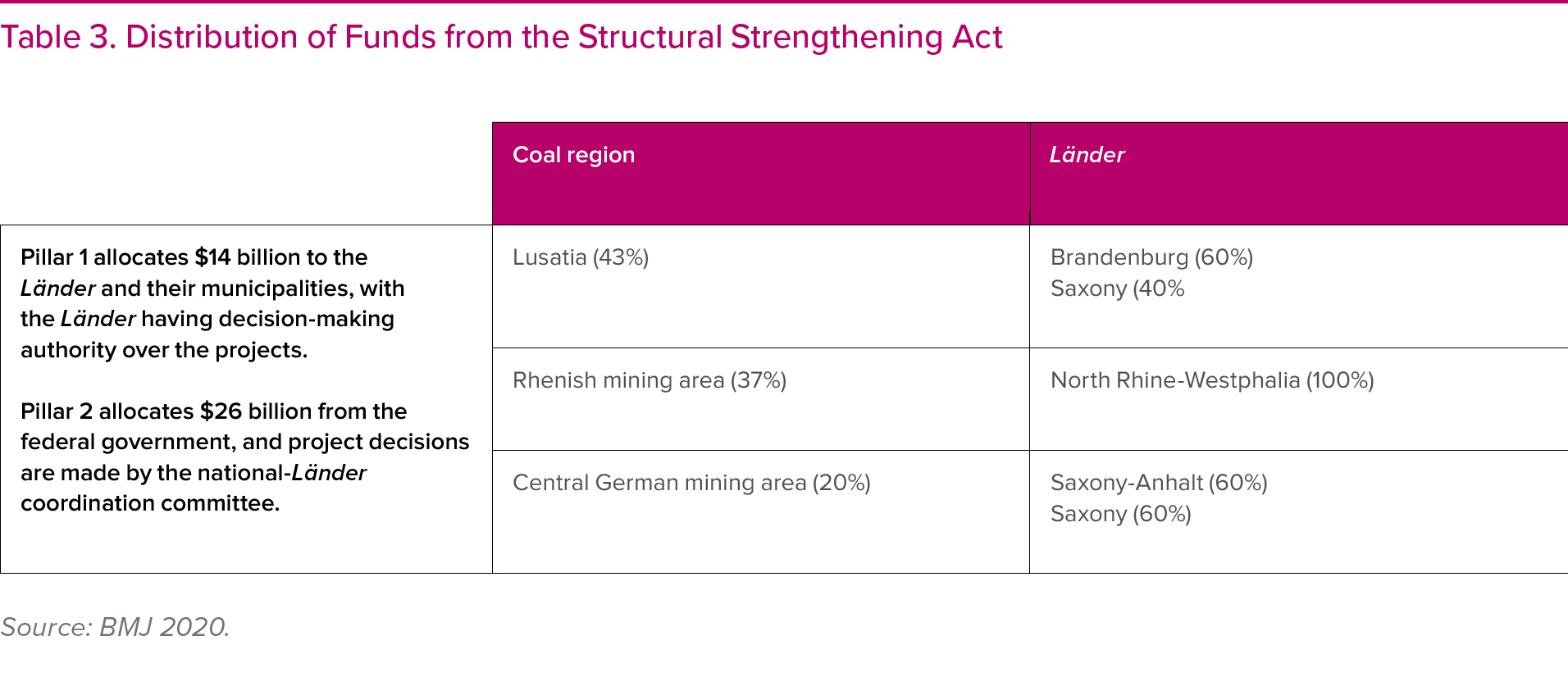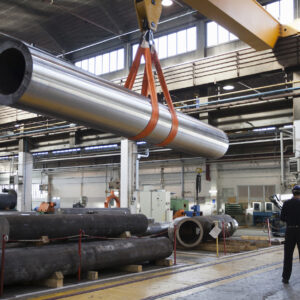Just Energy Transition in the Time of Place-Based Industrial Policy: Patch or Pathway to the Green Industrial Transformation?
February 12, 2024
By Andrea Furnaro
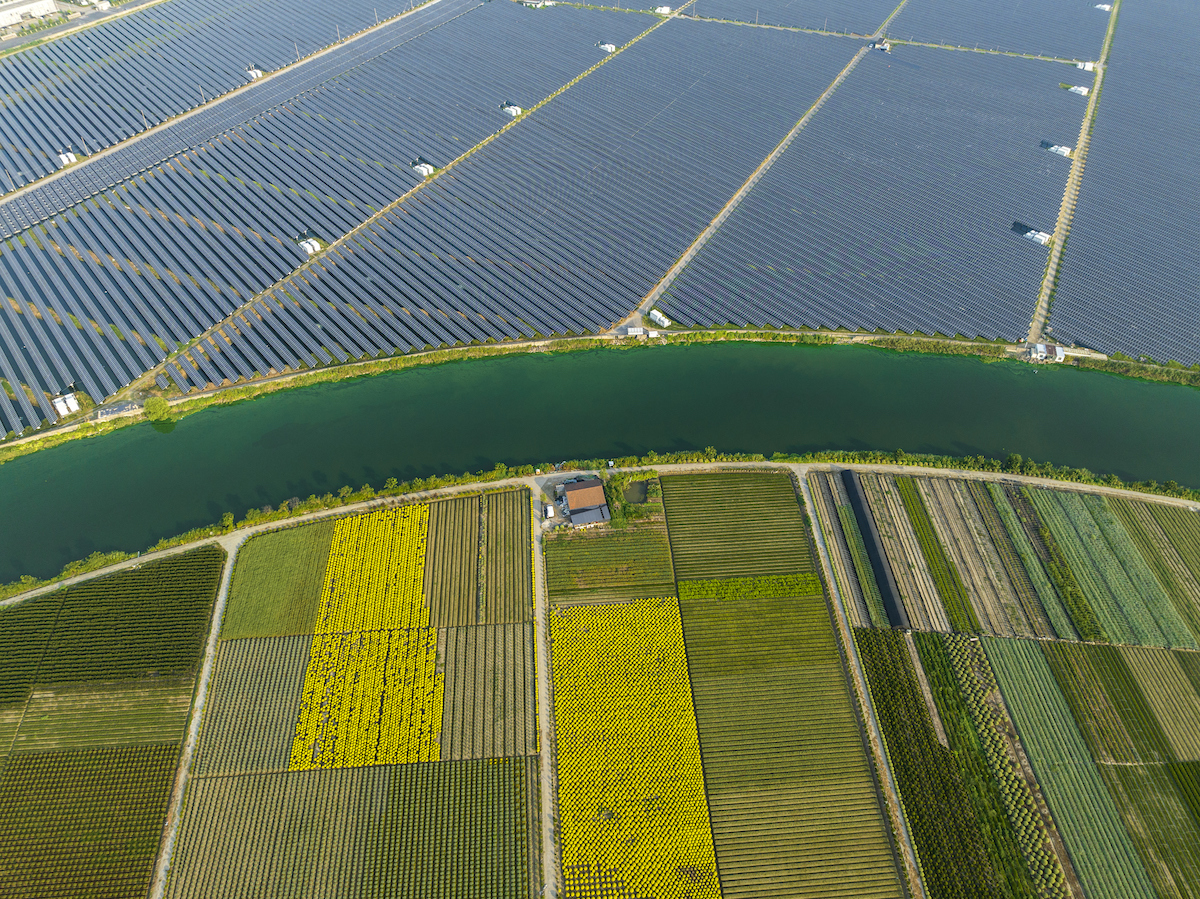
"Place-Based Industrial Policy (PBIP) represents a proactive approach to economic policy in which governments intervene not only in specific industries but also in specific locations to stimulate economic growth."
Introduction
In recent years, policymakers have witnessed a notable rise in two interconnected policy frameworks: Place-Based Industrial Policy and Just Transition Policy. Place-Based Industrial Policy (PBIP) represents a proactive approach to economic policy in which governments intervene not only in specific industries but also in specific locations to stimulate economic growth (Hafiz 2023). It recognizes the need to target strategic investments and interventions in regions that may be lagging behind economically. Just Transition Policies (JTP), on the other hand, especially those that emphasize subnational regions,1 are crafted to mitigate some of the adverse economic impacts associated with the shift from fossil fuel-based to more sustainable industries.
This essay examines the German experience with PBIP and JTP. Germany is notable for its extensive history of experimenting with JTP (even before this term was coined) (Oei et al. 2020; Furnaro et al. 2021). During different periods and to varying extents, Germany has also integrated place-based industrial policy approaches into its economic strategies. This has resulted in a complex landscape of tools and outcomes, with varying degrees of success over time (Schneider 2023). These policies have evolved to address the challenges of transitioning from coal and other fossil-fuel based industries to cleaner alternatives, fostering synergies between industrial and just transition policy.
The subsequent sections delve deeper into the literature of PBIP and JTP, placing emphasis on the trade-offs and challenges inherent in their relationship. The essay then emphasizes five key elements of the German experience: (i) educational and research investments, (ii) the debate around balancing support for incumbent and emerging sectors, (iii) anticipatory and proactive planning, (iv) spatial governance, and (v) a robust baseline.
The Rebirth of Place-Based Industrial Policy
Within the broader spectrum of industrial policy, PBIP is characterized by its deliberate focus on specific geographic locations, with the primary objective of transitioning the economic landscape of these areas toward higher-productivity activities (Neukman and Simpson 2015; Muro et al. 2022). What characterizes a PBIP as such is its intentionality—its explicit spatial targeting—rather than solely the localized outcomes it generates (since place-neutral industrial policies inadvertently yield geographically differentiated results).
What is defined as the targeted place can vary. It can encompass subnational regions, cities, municipalities, or other types of jurisdictions. It can focus on economically defined regions, such as innovation districts, special economic zones, and functional regions that may or may not overlap with specific jurisdictions. In some PBIPs of the European Union, such as the European Structural Fund, subnational regions from multiple countries are targeted (Notermans 2016). Some PBIPs target specific, named regions, such as the 1933 Tennessee Valley Authority (TVA) and the 1965 Appalachian Regional Commission (ARC) programs in the United States (Kline and Moretti 2014).2 Similarly, the 2020 Coal Phase-Out Act in Germany was designed to focus on the three remaining coal regions. In contrast, other policies target a particular category of region, as exemplified by the EU Structural Fund, which targets less developed regions. Within each region, PBIP initiatives can target either people, firms, broader industries, or organizations, just as is the case with spatially blind industrial policies.
For at least four decades, industrial policy was in decline and the conventional approach for economic policy in general was place-blind, with policies targeting individuals, industries, or firms without specific regard for geographic locations (Bailey et al. 2015). The underlying assumption was that place-based interventions are less effective as they might divert resources from industries and areas with growth potential that are better selected by the market alone, shrinking the overall national economic pie that could otherwise be better redistributed (Südekum 2021a). According to Bailey et al. (2015), the space-neutral approach was characterized by the belief that “spatial adjustments occur relatively smoothly between levels of equilibrium in response to market-based price and cost signals.”
Another criticism against PBIP centered on the potential to disproportionately benefit a select few, as these policies might be captured by a local elite, while other critiques argued that these policies are rarely able to reach local firms with high growth potential, as declining firms tend to have higher probability to access subsidies (Martin et al. 2011; Navaretti and Markovic 2021). A common object of concern in these critiques is related to the mobility of people and businesses. Workers and firms might respond to policy incentives by relocating to areas with more favorable conditions, potentially diluting the intended benefits. Additionally, as one area experiences growth through PBIP, it could potentially affect economic activity in other regions, prompting questions about the overall contribution to economic growth (Neukman and Simpson 2015).
Empirical evidence has played a significant role in driving the shift toward PBIP. A growing body of research has shown that place-based policies can promote regional economic growth, productivity, and employment (Lang et al. 2022; Becker et al. 2010; Busso et al. 2013; Seidel and von Ehrlich 2018). Researchers have increasingly recognized the economic benefits associated with promoting agglomeration economies, including enhanced innovation, knowledge spillovers, and increased productivity (Neukman and Simpson 2015). Studies have also demonstrated that perfect mobility by individuals is often an unrealistic assumption (Südekum 2021a). Factors such as housing costs and social ties limit individuals’ ability to relocate. This consideration is crucial, particularly since many regions—in the US and around the world—are witnessing a decrease in labor mobility (Neukman and Simpson 2015).
Another important driving force explaining the resurgence of PBIP is the increasing recognition of the political ramifications of neglecting economically disadvantaged regions and the resulting “geographies of discontent,” marked by a surge in political populism and polarization (De Ruyter et al. 2021). The shift from traditional manufacturing to knowledge-intensive services and digitalization, concentrating economic activities in urban centers, has worsened this spatial inequality (Südekum 2021a). This inequality can be further amplified by the phase-out of fossil fuel-related activities, which are often concentrated in rural or more remote regions (Tomer et al. 2021).
The literature on spatial—and particularly multilevel—governance, has contributed to the rebirth of PBIP by highlighting the significance of local perspectives in decision-making for more tailored interventions. Simultaneously, it highlights the strategic use of interactions between local and external actors and institutions to promote new knowledge and ideas, establish oversight, and mitigate the risk of disproportionately benefiting local elites, who, as per Barca (2011), may have a natural inclination to seek rent from public interventions. Striking this balance, however, is difficult. Multilevel governance entails addressing information gaps at both the national and local levels that limit optimal decision-making, particularly in the selection of investment alternatives (Bailey et al. 2015). Concurrently, the supervisory role of higher levels of government is essential but must be harmonized with the objective of “ensuring high-quality public spending without fostering a ‘culture of mistrust’ through excessive checks and controls that burden the involved parties” (Südekum 2021b).
Place-Based Industrial Policy Vis-à-Vis Just Transition Policy
The new wave of PBIP coincides with a surge in JTP. JTP refers to a set of strategies and interventions aimed at minimizing the social, economic, and environmental disruptions caused by transitions to more sustainable economic systems. These policies operate at various scales, from the global and national levels to regional and workplace contexts, and are designed to ensure that social groups affected by the transition process are supported, while also advancing broader environmental and social goals. While the term “just transition” initially emerged in the 1980s within the context of labor demands, it has seen rapid expansion in recent years to encompass various domains (Stevis and Felli 2020). In the context of subnational policies, which are the primary focus of this essay, JTPs constitute a form of place-based intervention aimed at mitigating the adverse consequences arising from the transition to low-carbon energy, especially in regions economically reliant on fossil fuel-related activities.
Nonetheless, these two approaches frequently differ in scope. JTPs typically encompass a broader array of elements that extend beyond economic development, often placing a strong emphasis on social policies. PBIPs may emphasize other types of economic initiatives, particularly when their primary objective is to bolster promising regions rather than those experiencing economic decline. A prime example can be observed in regions that are not necessarily dependent on fossil fuel-related activities but possess abundant resource endowments or other competitive advantages in cleaner industries, such as regions with high solar radiation or geological conditions for carbon storage (e.g., Bnamericas 2023; Gardner 2022).
PBIP and JTP can also be seen as complementary tools for addressing the complex challenges of a green industrial transformation. JTP can help address some of the economic problems associated with a “picking the winners” approach, which tends to favor certain industries at the expense of others (potentially shrinking the overall economic pie) and to concentrate economic activity in specific regions (contributing to regional inequality). The utilization of JTP can help address other issues associated with PBIP, such as the concentration of benefits among economic elites, rising rent prices, and employer monopolies in specific regions. However, it’s crucial to acknowledge that policy efforts to stimulate economically distressed regions through incentives for innovations and technological clusters have had mixed success (Lerner 2009; Glaeser and Hausman 2019). The effectiveness of PBIP is still an area in which more impact analyses are needed. Certain PBIP initiatives have become more similar to, rather than complementary with, JTP, particularly when they incorporate a proactive component and substantial funds to support regions at risk as a result of the green industrial transformation (see Table 2 for a summary). A key debate in the context of PBIP/JTP is whether policies should focus on productive investments within sectors that are already dominant, leveraging existing (static) competitive advantages, as opposed to promoting new (dynamic) sectors (Armitage et al. 2023). Smart specialization, a principle highlighted by the OECD for good place-based policies, encourages regions to leverage their available local competencies (OECD 2020). However, other analysts advise caution with path-dependent approaches, as they may favor incumbent large firms and hinder new entrants and more radical innovation (Armitage et al. 2023; based on Agrawal et al. 2010 and Chatterji et al. 2014). Instead, PBIP in economically declining regions should support emerging sectors that hold potential for agglomeration effects, regardless of existing economic activities. For instance, nascent industries like hydrogen and direct air capture have the capacity to generate synergies among innovation, environmental, and equity objectives. According to Armitage et al. (2023), agglomeration benefits in disadvantaged regions can be promoted when these benefits are specific to the novel technologies (rather than cumulative with existing ones). They suggest that by introducing these nascent industries in disadvantaged regions or those expected to face challenges in the transition away from fossil fuels, policymakers can mitigate regional inequalities while tapping into future agglomeration benefits (Armitage et al. 2023).
Relating Place and the Just Transition in Place-Based Industrial Policymaking: The German Case
Germany has not been immune to the global shift away from industrial policies, including PBIP, since the 1980s (Schneider 2023). Furthermore, the country’s so-called “ordo-liberal” approach, characterized by the state’s role being confined to the creation of a framework for market competition, has continued to exert influence (Kattel et al. 2020). However, mirroring the global trend, recent years have witnessed a resurgence in both industrial policy and PBIP in Germany, accompanied by the emergence of explicit JTPs.
The country has established various initiatives aimed at supporting coal regions impacted by the energy transition through PBIP. Among these, the most recent and significant is the Structural Strengthening Act (Strukturstärkungsgesetz), allocating 40 billion euros to the remaining lignite regions (Lusatia, Rhenish mining area, and Central German mining area) by 2038 (see Figure 1). Additionally, the act provides up to €1 billion for particularly affected hard coal power plant sites and up to €90 million each for the former coal regions of Helmstedt and Altenburger. Furthermore, European funding is accessible through the Just Transition Fund, which allocates €375 million to Lusatia, €200 million to the Central German mining area, and €70 million to the city of Chemnitz.
This policy has been formulated not only as a response to the adverse effects associated with the green industrial transformation, particularly Germany’s green energy transition policy process (the Energiewende), but also as a proactive implementation of PBIP. According to the government, the Structural Strengthening Act “is not only intended to mitigate the consequences of the phase-out of coal-fired power generation. Rather, the coal regions should be given a real chance to be in a better position after the coal phase-out than before” (BMWK 2020).
The subsequent sections illustrate important aspects of Germany’s approach to connecting both JTPs and PBIPs.
Educational and Research Investments
One aspect that has been central to the German approach to achieving both economic growth and just transition objectives, and which has been relatively stable over time, is the focus on educational and research investments from a place-based perspective. In the historical policies aimed at supporting economically struggling coal regions, especially in the Ruhr region, public support for local universities and research institutions played a pivotal role (Keil and Wetterau 2013). Today, “with 22 universities and colleges, the Ruhr region has the highest density of further education establishments anywhere in Europe” (Metropoleruhr 2021).
The focus on funding existing and supporting new educational and research institutions persists in contemporary PBIP to support coal regions, for example with funds to set up new applied science and research institutions that can contribute to innovation efforts (Sächsisches Staatsministerium für Regionalentwicklung n.d.b.; Lausitz Staatskanzlei 2020). Germany is known internationally for its focus on state-directed funding to nonuniversity research institutions and applied sciences, something that has scarcely changed in the past three decades (EFI 2022; Kattel et al. 2020). Per Südekum (2021b), education within PBIP serves as a potential win-win approach, aligning regional and national economic growth with social equity objectives. Investments in education yield significant returns, both individually and societally, by enhancing productivity, boosting output, increasing wages and tax revenue, and creating future economic value that would otherwise remain unrealized without these investments.
Balancing Support for Incumbent and Emerging Sectors
Soete and Stierna (2023) argue that Europe’s current regional development and cohesion strategies, exemplified by regional smart specialization strategies, tend to prioritize “incremental” improvements, shying away from more disruptive changes (Soete and Stierna 2023). The extent to which investments supporting coal regions in Germany should follow a similar approach remains a subject of open debate in the country (Pomp 2023).
The Investment Act for Coal Regions, a complementary regulation to the Structural Strengthening Act, does not offer a rigidly defined framework for the types of investments that should receive support. It outlines two main investment criteria: (i) create and maintain jobs and training positions in the regions and (ii) diversify the economic structure of the region and improve its attractiveness as a business location (BJM 2020). This Act, however, incorporates comprehensive plans for the three lignite regions, explicitly stating the goal of preserving their role as “energy” regions or areas (BJM 2020). In practice, investment plans have prominently targeted hydrogen, renewables, and electricity storage projects, capitalizing on existing energy sector expertise and infrastructure. Furthermore, the coal phase-out policy has prompted the establishment of new centers for applied research in these technologies (Sächsisches Staatsministerium für Regionalentwicklung n.d.b.; Lausitz Staatskanzlei 2020). These decisions are not only based on economic reasons but also influenced by political factors, as the shift from “coal regions” to “energy regions” garners more local support, boosting both economic and representational path dependency in the transition process. However, it is not always clear whether this focus on energy investment truly reflects the best local competitive capacities (Pomp 2023).
Anticipatory and Proactive Planning
A key aspect of the German Coal Phase-Out Act is the allocation of substantial funds to compensate regions for the phase-out of coal. This provision is contingent upon the successful execution of the phase-out agenda that sets 2038 as the latest year possible for coal extraction and power production (German Federal Government n.d.). This anticipatory approach is characterized by a proactive preparation for an anticipated decline in regional economic activities rather than a reactive response.
Having a phase-out schedule was not solely a decarbonization goal for German policymakers but also a planning strategy. The notion of ensuring “planning security” (Planungssicherheit) was often raised in public discussions by trade unions, local politicians, and industry representatives. This involves allowing sufficient time for planning the integration of clean energies and the phase-out of coal electricity into the system, reducing energy supply risks as well as ensuring enough time to plan and execute the retraining or conversion of workers to capitalize on their skills. Proactive planning can help reduce the risk of some PBIPs substituting local labor with increased capital gains for firms without necessarily, or to the same extent, raising local wages—a problem that limits the capacity of these policies to effectively address regional economic growth and disparity (Lang et al. 2022). While the planning capacity of the German coal exit process has faced criticism from various actors,3 from an international standpoint, it stands as a noteworthy example of forward planning for the decline of a dominant industry.
Spatial Governance
A significant challenge that arises for regions that aspire to implement industrial policies is that they may lack the necessary regulatory and financial capacities.4 The rebirth of PBIP and the emergence of JTP are not taking place in a vacuum but in a context in which in many countries’ local governments have been underfunded because of long-term austerity policies (Featherstone et al. 2012). In the case of the EU, McNamara (2023) highlights the need to question the EU’s ability to execute industrial policy, given its limited fiscal capacity and lack of traditional state governance and control mechanisms. This limitation could potentially challenge Europe’s efforts, particularly in matching the Biden administration’s industrial policy and green transition financing.
Germany has partially addressed this issue in its JTP and PBIP by trying to promote the financial and technical capabilities of local governments. Both historical and contemporary JTPs have directly provided economic assistance to local governments (Furnaro et al. 2021).
Within the Structural Strengthening Act, program implementation is supervised by a committee comprising the national government and the federal states (or Länder) in which the lignite regions are situated (Brandenburg, Saxony, Saxony-Anhalt, and North Rhine-Westphalia). All measures to be funded under Pillar 2 (see Table 3) must receive approval from this committee. Decisions are made through a voting process involving the federal government and at least half of the Länder votes. Each Länder holds one vote, and a recommendation cannot be made against the vote of the national federal department or Länder involved. The definition of specific projects must align with the framework outlined in the Coal Regions Investment Act and the mission statements and regional development concepts of the Länder, regions, and municipalities (BMWK 2020).
Municipalities tend to play an active role by having the ability to propose and seek funding for specific investment projects. In various coal regions, municipal and other local stakeholders have engaged in dialogue processes to formulate project proposals (MHKBD 2022; WRL 2023). The utilization of competitive mechanisms for allocating grants among local participants is a central feature of this policy, promoting local cooperation and networking (see Muro et al. 2022).
There are significant differences in the types of projects selected and procedures in different regions, especially under Pillar 1 of this policy, with, for example, a more top-down selection process in Brandenburg and a more bottom-up approach in Saxony-Anhalt in comparison with other Länder (IWH 2023).
Technical advisory centers have been established to assist local stakeholders in bridging capacity gaps related to the successful submission and management of projects. These centers aim to address issues such as insufficient municipal staffing or a lack of personnel with the required competencies (MHKBD 2022), helping overcome common barriers faced by local stakeholders with less economic resources, such as limited knowledge about policies and administrative procedures (Bailey et al. 2015). Furthermore, the offices of new and existing national and Länder-level authorities are often established in these regions to create local jobs and decentralization. This approach also promotes vertical coordination among various levels of government by having their offices located in proximity (BMWi 2021).
However, the multilevel governance of the policies to support lignite regions has faced criticism for not adequately involving local representatives, with predominant roles still played by representatives from both the Länder and the national level in defining funding priorities. Additionally, there have been concerns about the limited inclusion of less heard local voices, such as those of women or migrants (Walk et al. forthcoming).
Constraints imposed by EU state aid and competition rules have been central to discussions on how to effectively utilize the funds allocated by the Structural Strengthening Act. Policymakers have sought to tackle this challenge through various strategies, including a focus on direct investments in business-related infrastructure (such as industrial land-efficient and energy-efficient building renovations), public infrastructure (including transportation, digitalization, urban development, health and cultural facilities, and tourist infrastructure), and research and education (BMJ 2020). One of the projects financed through this approach is the construction of the largest railway in Europe in Lusatia, although it has faced criticism due to its high costs and unclear benefits (Wüpper 2021).
The Baselines
The recent resurgence of PBIP in the United States has prompted questions about whether Germany and Europe are lagging behind in similar efforts (MacKinnon et al. 2023). But it’s important to take into account the totality of PBIPs that have long been in place (IWH 2023). This is particularly important in Germany, where the aim of achieving equitable living standards across regions is explicitly included in the constitution. In the German context, the social security system, labor system, and system for regional fiscal equalization should be seen as the baseline for additional PBIPs and JTPs (Furnaro et al. 2021). Following Kattel et al. (2020), some of these can be better described as a form of “‘stealth’ industrial policy that tends to fly under the radar of domestic and international policy discussions.”
In 2020 alone, the federal government provided over €1.7 billion to structurally weak regions throughout Germany through the programs of the All-German Support System (Gesamtdeutschen Fördersystems). This amount is not significantly less than the approximately €2.3 billion provided annually to the coal regions by the Structural Strengthening Act (BMWi 2021). This aligns with data indicating that Germany is one of the five OECD countries in which subnational government expenditures accounted for the largest share of general government expenditures in 2020, a trend that has been consistently observed in previous years (see Figure 2).
Conclusion
The recent increase in both PBIP and JTP reactivates important policy questions about the capacity of large-scale financial support for specific regions to stimulate both regional and national economic growth. From a policy perspective, it is crucial to analyze the challenges and opportunities in balancing the relationship between PBIP and JTP. Potential trade-offs can arise concerning resources allocated in promoting regions with growth potential or regions in or under risk of economic decline, in promoting equity or efficiency in PBIPs, and in prioritizing short-term relief or long-term growth and sustainability regionally.
In this context, the relevant question isn’t solely about how to make PBIP more equitable, but rather how to integrate PBIP and JTP to enhance the effectiveness of both.
While JTP is commonly viewed as a patch to address some of the negative impacts of green industrial transformations, often from an equity perspective, the German case demonstrates an attempt to integrate BPIP and JTP approaches more closely. Different elements of the approach used in the Structural Strengthening Act, which explicitly attempts to incorporate both approaches, were highlighted in this essay. Most of the results, however, are still to be seen.
The German model of prioritizing educational and research investments in PBIP and JTP, with a special focus on nonuniversity research institutions and applied sciences, offers valuable insights, although its direct application in the US would require adaptations to the local context. This includes considering, for example, the role of private-sector innovation, the need for integration with broader economic strategies, and the alignment of these investments with the specific needs of transitioning regions, which requires integration with regional economic strategies and labor markets.
The issue of the degree to which path dependencies and disruptions should be promoted is critical in this regard and is not a settled conclusion in Germany, although we see today a tendency to promote the transition from coal to energy regions. However, this approach can limit the scope for diversification. A critical concern to take into account in Germany and beyond is how to promote a correct balance between a strategy that might reinforce existing economic structures at the expense of hindered adaptability and the introduction of emerging industries without causing undue disruption to existing labor markets and community structures.
The German Coal Phase-Out Act emphasizes the importance of the active role of the state in regulating exnovation (the divestment from old energy technologies and production structures) (David 2018) with an anticipatory approach as part of this green industrial policy framework. From this perspective, phase-out agendas can help manage the transition and create economic gains, an anticipatory approach that underscores a fundamental aspect of how Germany is trying to harmonize JTP with PBIP. The applicability of a similar approach in the US depends on complex issues such as political will, regulatory challenges for the central planning of industry declines, and federal-state dynamics in decision-making.
Germany provides numerous examples of the complexities involved in navigating multilevel governance within PBIP. This particularly pertains to how to effectively support regions in implementing investment projects by promoting administrative decentralization and financial and technical support for local governments, although many questions about how to prevent elite capture of benefits remain unanswered. The US capacity to address these issues depends not only on the level of decentralizing decision-making but also of the ability to equip local governments with the necessary resources and expertise. While local governments in Germany have the freedom to propose and seek funding for projects, these must align with broader national and state objectives. The US can learn from this model to ensure that local initiatives contribute to national industrial strategies without stifling local innovation and priorities and the need for collaboration and coordination mechanisms that respect the autonomy of states and local governments while pursuing shared national economic goals.
Finally, relying on robust baselines, which are far from perfect in Germany, rather than solely on hyper-targeted just transition interventions, is crucial, especially as numerous processes of green industrial disruption are anticipated in the near future. They can enhance resilience, foster greater regional cohesion, and ultimately mitigate some of the social and political implications associated with overlooking regional economic decline. The implementation of such policies, however, would require significant structural reforms in countries like the US, which could face political and fiscal challenges in addition to the complexities due to higher decentralization in key policy areas that underpin these baselines.
_____
The author would like to thank Todd Tucker for his comments and Claire Greilich and Sonya Gurwitt for their editorial contributions. Special thanks to Nora Stognief and Marius Koepchen for their valuable suggestions on earlier versions of this essay.
Footnotes
Read the footnotes
1Just transition policies can encompass a much broader range of interventions, including support for workers in fossil fuel industries affected by the energy transition, communities adversely impacted by the expansion of projects to extract minerals needed for the energy transition, communities affected by new renewable energy investments, or developing countries rich in fossil fuels, among others.
2Biden’s recent policies allocated $80 billion for place-based spending, which is eight times more than the amount allocated for TVA or ARC.
3This includes, for example, representatives of environmental organizations arguing that it doesn’t provide enough planning capacity to ensure a rapid incorporation of renewable energies (Mieritz 2019) and representatives from the steel industry and the right-wing populist party Alternative für Deutschland who have argued that these laws don’t protect planning security to avoid future energy supply disruptions (Home of Welding 2020; Deutscher Bundestag 2020).
4For instance, in the United States, despite former Los Angeles Mayor Eric Garcetti’s use of Green New Deal rhetoric to characterize the city’s sustainability plan, regulatory and financial limitations constrain the city’s ability to raise and allocate sufficient funds for a robust PBIP (Furnaro and Kay 2022).
References
Read the references
Agrawal, Ajay K., Iain M. Cockburn, and Carlos Rosell. 2009. “Not Invented Here? Innovation in Company Towns.” Working Paper no. 15437. NBER Working Paper Series. Cambridge, MA: National Bureau of Economic Research. https://www.nber.org/papers/w15437.
Armitage, Sarah C., Noël Bakhtian, and Adam B. Jaffe. 2023.
“Innovation Market Failures and the Design of New Climate Policy Instruments.” Working Paper no. 31622. NBER Working Paper Series. Cambridge, MA: National Bureau of Economic Research. https://www.nber.org/papers/w31622.
Bailey, David, Paul Hildreth, and Lisa De Propris. 2015. “Mind the Gap! What Might a Place-Based Industrial and Regional Policy Look Like.” In New Perspectives on Industrial Policy for a Modern Britain, edited by David Bailey, Keith Cowling, and Philip Tomlinson. Oxford, UK: Oxford University Press. https://academic.oup.com/book/4606/chapter-abstract/146737525?redirectedFrom=fulltext.
Barca, Fabrizio. 2011. “Alternative Approaches to Development Policy: Intersections and Divergences.” In OECD Regional Outlook 2011: Building Resilient Regions for Stronger Economies. Paris: Organisation for Economic Co-operation and Development (OECD). https://www.oecd-ilibrary.org/urban-rural-and-regional-development/oecd-regional-outlook-2011/alternative-approaches-to-development-policy_9789264120983-17-en.
Becker, Sascha O., Peter H. Egger, and Maximilian von Ehrlich. 2010. “Going NUTS: The Effect of EU Structural Funds on Regional Performance.” Journal of Public Economics 94, no. 9-10 (October): 578–590. https://www.sciencedirect.com/science/article/abs/pii/S004727271000071X.
BJM. 2020. “Investitionsgesetz Kohleregionen [Investment Act for Coal Regions], BMJ 2020, S. 2922.” https://www.gesetze-im-internet.de/invkg/BJNR179510020.html.
Bundesministerium für Wirtschaft und Energie (BMWi). 2021. Jahresbericht der Bundesregierung zum Stand der Deutschen Einheit 2021. Berlin: Bundesministerium für Wirtschaft und Klimaschutz. https://www.bmwk.de/Redaktion/DE/Publikationen/Neue-Laender/2021-jahresbericht-der-bundesregierung-zum-stand-der-deutschen-einheit-jbde.html.
Bundesministerium für Wirtschaft und Klimaschutz (BMWK). 2020. “Strukturstärkungsgesetz Kohleregionen.” BMWK, September 24, 2020. https://www.bmwk.de/Redaktion/DE/Textsammlungen/Wirtschaft/strukturstaerkungsgesetz-kohleregionen.html.
Bnamericas. 2023. “What Mexico’s US $48bn Sonora Renewables Plan Is Really All About.” Bnamericas, January 18, 2023. https://www.bnamericas.com/en/interviews/what-mexicos-us48bn-renewables-plan-is-really-all-about.
Busso, Matias, Jesse Gregory, and Patrick Kline. 2013. “Assessing the Incidence and Efficiency of a Prominent Place Based Policy.” American Economic Review 103, no. 2 (April): 897–947. https://www.aeaweb.org/articles?id=10.1257/aer.103.2.897.
Chatterji, Aaron, Edward Glaeser, and William Kerr. 2014. “Clusters of Entrepreneurship and Innovation.” Innovation Policy and the Economy 14: 129–166. https://www.journals.uchicago.edu/doi/full/10.1086/674023.
Commission of Experts for Research and Innovation (EFI). 2022. Report on Research, Innovation and Technological Performance in Germany 2019. Berlin: EFI. https://www.econstor.eu/bitstream/10419/204778/1/167926883X.pdf.
Deutscher Bundestag. 2020. “Bundestag Beschließt das Kohleausstiegsgesetz.” Energie. Last accessed January 3, 2024. https://www.bundestag.de/dokumente/textarchiv/2020/kw27-de-kohleausstieg-701804.
David, Martin. 2018. ‘Exnovation as a Necessary Factor in Successful Energy Transitions’, in Debra J. Davidson, and Matthias Gross (eds), Oxford Handbook of Energy and Society, Oxford Handbooks (2018; online edn, Oxford Academic, 10 July 2018), https://doi.org/10.1093/oxfordhb/9780190633851.013.0027.
De Ruyter, Alex, Ron Martin, and Tyler Peter. 2021. “Geographies of Discontent: Sources, Manifestations and Consequences.” Cambridge Journal of Regions, Economy and Society 14, no. 3 (September): 381-393. https://academic.oup.com/cjres/article/14/3/381/6362486.
German Federal Government. n.d. “Ending Coal-Generated Power.” FAQs to Ending the Use of Coal. Accessed January 3, 2024. https://www.bundesregierung.de/breg-en/service/archive/kohleausstiegsgesetz-1717014.
Glaeser, Edward L., and Naomi Hausman. 2019. “The Spatial Mismatch between Innovation and Joblessness.” NBER Working Paper Series. Working Paper 25913. Cambridge, MA: National Bureau of Economic Research. https://www.nber.org/papers/w25913.
Furnaro, Andrea, Philipp Herpich, Hanna Brauers, Pao-Yu Oei, Claudia Kemfert, and Wesley Look. 2021. German Just Transition: A Review of Public Policies to Assist German Coal Communities in Transition. New York: Environmental Research Fund. https://media.rff.org/documents/21-13-Nov-22.pdf.
Furnaro, Andrea, and Kelly Kay. 2022. “Labor Resistance and Municipal Power: Scalar Mismatch in the Los Angeles Green New Deal.” Political Geography 98, (October): 102684. https://www.sciencedirect.com/science/article/abs/pii/S0962629822000981?via%3Dihub.
Featherstone, David, Anthony Ince, Danny Mackinnon, Kendra Strauss, and Andrew Cumbers. 2012. “Progressive Localism and the Construction of Political Alternatives.” Transactions of the Institute of British Geographers 37, no. 2: 177–182. https://www.jstor.org/stable/41427938.
Hafiz, Hiba. 2023. “The Law of Geographic Labor Market Inequality.” University of Pennsylvania Law Review 172 (March). https://ssrn.com/abstract=4342785.
Home of Welding. 2020. “Kohleausstiegsgesetz ohne Planungssicherheit für Stahlindustrie.” Home of Welding, January 29, 2020. https://www.home-of-welding.com/news/kohleausstiegsgesetz-ohne-planungssicherheit-fur-stahlindustrie-569.
IWH. 2023. Begleitende Evaluierung des Investitionsgesetzes Kohleregionen (InvKG) und des STARK-Bundesprogramms. https://www.iwh-halle.de/publikationen/detail/begleitende-evaluierung-des-investitionsgesetzes-kohleregionen-invkg-und-des-stark-bundesprogramms/.
McNamara, Kathleen. 2023. “Transforming Europe? The EU’s Industrial Policy and Geopolitical Turn.” Journal of European Public Policy (July). https://www.tandfonline.com/doi/abs/10.1080/13501763.2023.2230247.
Kattel, Rainer, Mariana Mazzucato, Keno Haverkamp, and Josh Ryan-Collins. 2020. “Challenge-Driven Economic Policy: A New Framework for Germany“. Working Paper no. 05 2020. Forum New Economy Working Papers. Berlin: Forum for a New Economy. https://www.ucl.ac.uk/bartlett/public-purpose/publications/2020/nov/challenge-driven-economic-policy-new-framework-germany.
Keil, Andreas, and Burkhard Wetterau. 2013. Metropolis Ruhr: A Regional Study of the New Ruhr. Essen: Metropolis Ruhr. https://www.geographie.uni-wuppertal.de/uploads/media/Metropolis_Ruhr-1_02.pdf.
Kline, Patrick, and Moretti, Enrico. 2014. “Local Economic Development, Agglomeration Economies, and the Big Push: 100 Years of Evidence from the Tennessee Valley Authority.” Quarterly Journal of Economics 129, no. 1 (February): 275-331. https://www.jstor.org/stable/26372549.
Lang, Valentin, Nils Redeker, and Daniel Bischof. 2022. “Place-Based Policies and Inequality within Regions.” Peoria, IL: OSF Preprints. https://osf.io/preprints/osf/2xmzj.
Lausitz Staatskanzlei. 2020. “Das Lausitzprogramm 2038: Prozesspapier zum Aufbau von Entscheidungs- und Begleitstrukturen im Transformationsprozess.” Lusatia, Germany: Lausitz-Beauftragter des Ministerpräsidenten. https://lausitz-brandenburg.de/wp-content/uploads/2020/09/Lausitzprogramm-2038_20200914.pdf.
Lerner, Josh. 2009. Boulevard of Broken Dreams: Why Public Efforts to Boost Entrepreneurship and Venture Capital Have Failed—and What to Do about It. Princeton, NJ: Princeton University Press.
MacKinnon, Danny, Nadir Kinossian, Andy Pike, Vincent Béal, Thilo Lang, Max Rousseau, and John Tomaney. 2023. “Spatial Policy Since the Global Financial Crisis.” Working Paper no. 05/23. Beyond ‘Left Behind Places’ Working Paper Series. Newcastle, UK: Newcastle University. https://research.ncl.ac.uk/beyondleftbehindplaces/publicationsanddownloads/Spatial%20policy%20since%20the%20global%20financial%20crisis_WP%20version.pdf.
Martin, Philippe, Thierry Mayer, and Florian Mayneris. 2011. “Public Support to Clusters: A Firm Level Study of French ‘Local Productive Systems.’” Regional Science and Urban Economics 41, no. 2 (March): 108-123. https://www.sciencedirect.com/science/article/abs/pii/S0166046210000712.
metropoleruhr. 2021. Education: Studying in the Ruhr Region. 2021. https://www.welcome.ruhr/en/the-ruhr-region/education/#:~:text=With%2022%20universities%20 and%20colleges,state%20distance%20university%20in%20Germany.
Ministerium für Heimat, Kommunales, Bau, und Digitalisierung des Landes Nordrhein-Westfalen (MHKBD). 2022. “ReVierwins.” Themenportal. Last accessed December 29, 2023. https://www.mhkbd.nrw/themenportal/reviergewinnt.
Mieritz, Tina. 2019. “Der Kohleausstieg ist eine Schnecke.” Naturschutzbund Deutschland (NABU), January 29, 2019. https://www.nabu.de/umwelt-und-ressourcen/energie/fossile-energien/stein-und-braunkohle/27455.html.
Muro, Mark, Robert Maxim, Joseph Parilla, and Xavier de Souza Briggs. 2022. “Breaking Down an $80 Billion Surge in Place-Based Industrial Policy.” Brookings Institution, December 15, 2022. https://www.brookings.edu/articles/breaking-down-an-80-billion-surge-in-place-based-industrial-policy/.
Navaretti, Giorgio Barba, and Borisav Markovic. 2021. “Place-Based Policies and the Foundations of Productivity in the Private Sector.” Organisation for Economic Co-operation and Development (OECD), March 23, 2021. https://www.oecd.org/regional/W2-S2-Navaretti-Markovic.pdf.
Neukman, David, and Helen Simpson. 2015. “Do Place-Based Policies Matter?” Federal Reserve Bank of San Francisco, March 2, 2015. https://www.frbsf.org/economic-research/publications/economic-letter/2015/march/enterprise-zone-economic-incentive-tax-subsidy-place-based-policies/.
Notermans, Ton. 2016. “Does Cohesion Policy Lead to Economic Convergence?” In Handbook on Cohesion Policy in the EU, edited by Simona Piattoni and Laura Polverari. Cheltenham, UK: Edward Elgar Publishing. https://www.e-elgar.com/shop/usd/handbook-on-cohesion-policy-in-the-eu-9781784715663.html.
Organisation for Economic Co-operation and Development (OECD). 2020. Broad-Based Innovation Policy for All Regions and Cities. Paris: OECD Publishing. https://doi.org/10.1787/299731d2-en.
_______2023. “Subnational Governments in OECD Countries: Key Data.” OECD.stat. Last updated December 29, 2023. https://stats.oecd.org/Index.aspx?DataSetCode=SNGF.
Pao-Yu Oeia, Hanna Brauers, and Philipp Herpich. 2020. “Lessons from Germany’s Hard Coal Mining Phase-Out: Policies and Transition from 1950 to 2018.” Climate Policy 20, no. 8 (Novemeber): 963-979. https://www.tandfonline.com/doi/full/10.1080/14693062.2019.1688636.
Pomp, Caron. 2023. “The Regional Innovation System and Smart Specialisation in the ‘Energy Region’ Lusatia.” List Forum für Wirtschafts-und Finanzpolitik (August): 1-24. https://link.springer.com/article/10.1007/s41025-023-00250-5.
Gardner, Timothy. 2022. “US Agrees $500 Mln Loan Guarantee for Utah Hydrogen Storage Project.” Reuters, June 8, 2022. https://www.reuters.com/business/energy/us-agrees-500-mln-loan-guarantee-utah-hydrogen-storage-project-2022-06-08/.
Sächsisches Staatsministerium für Regionalentwicklung. n.d.a. “Innovation und Wettbewerbsfähigkeit Fördern.” Strukturentwicklung in den sächsischen Braunkohleregionen. Accessed December 29, 2023. https://www.strukturentwicklung.sachsen.de/innovation-und-wettbewerbsfahigkeit-fordern-4391.html.
_______ n.d.b. “Energieeffizienz und Erneuerbare Energien Ausbauen.” Strukturentwicklung in den sächsischen Braunkohleregionen. Accessed December 29, 2023. https://www.strukturentwicklung.sachsen.de/energieeffizienz-und-erneuerbare-energien-ausbauen-4389.html.
Schneider, Etienne. 2022. “Germany’s Industrial Strategy 2030, EU Competition Policy and the Crisis of New Constitutionalism. (Geo-)Political Economy of a Contested Paradigm Shift.” New Political Economy 28, no. 2 (June): 241–258. https://doi.org/10.1080/13563467.2022.2091535.
Seidel, Tobias and Maximilian von Ehrlich. 2018. “The Persistent Effects of Regional Policy. Evidence from the West-German Zonenrandgebiet.” American Economic Journal: Economic Policy 10, no. 4 (November): 344–374. https://www.aeaweb.org/articles?id=10.1257/pol.20160395.
Soete, Luc, and Johan Stierna. 2023. ”Revisiting Schumpeter in Europe: Place-Based Innovation and Transformative Industrial Policy.” Working Paper no. 2023-022. Maastricht, the Netherlands: United Nations University-Maastricht Economic and Social Research Institute on Innovation and Technology (MERIT). https://cris.maastrichtuniversity.nl/ws/portalfiles/portal/139062100/wp2023_022.pdf.
Stevis, Dimitris, and Romain Felli. 2020. “Planetary Just Transition? How Inclusive and How Just?” Earth System Governance 6, no. 100065 (December). https://www.sciencedirect.com/science/article/pii/S2589811620300240.
Südekum, Jens. 2021a. “Place-Based Policies: How to Design Them and Why.” Industrial Analytics Platform, November 2021. https://iap.unido.org/articles/place-based-policies-how-design-them-and-why.
_______2021b. “Productivity Policy for Places–Inclusive Productivity.” Organisation for Economic Co-operation and Development (OECD), May 18, 2021. https://www.oecd.org/regional/W4-S2-Jens_Suedekum.pdf.
Tomer, Adie, Joseph W. Kane, and Caroline George. 2023. How Renewable Energy Jobs Can Uplift Fossil Fuel Communities and Remake Climate Politics. Washington, DC: Brookings Institution. https://www.brookings.edu/articles/how-renewable-energy-jobs-can-uplift-fossil-fuel-communities-and-remake-climate-politics/#2.
Walk, Paula, Marius Koepchen, Nora Stognief, and Johannes Probst. Forthcoming. “Tracing a Caring Transition Policy for the German Coal Region Lusatia.” Sustainability Nexus Forum.
Wirtschafts Region Lausitz (WRL). 2023. “Über Uns.” Accessed December 29, 2023. https://wirtschaftsregion-lausitz.de/ueber-uns/.
Wüpper, Thomas. 2021. “Ausbau Ohne Tempo: Bahnprojekte in Der Lausitz Kommen Kaum Voran.” Tagesspiegel, July 12, 2021. https://www.tagesspiegel.de/berlin/bahnprojekte-in-der-lausitz-kommen-kaum-voran-8000275.html.
US Department of Treasury. 2022. “Remarks by Secretary of the Treasury Janet L. Yellen at Ford Rouge Electric Vehicle Center.” Press release, September 8, 2022. https://home.treasury.gov/news/press-releases/jy0939.
Explore the Series
The Role of State Ownership: Overview of State-Owned Entities in the Global Economy
by Kyunghoon Kim

Finance as a Tool of Industrial Policy: A Taxonomy of Institutional Options
by Saule T. Omarova
Leading With Industrial Policy: Lessons for Decarbonization from Swedish Green Steel
by Jonas Algers
Fair Transition Funds, Employer Neutrality, and Card Checks: How Industrial Policy Could Relaunch Labor Unions in the United States
by César F. Rosado Marzán
Electric Vehicles: How Corporate Guardrails Can Improve Industrial Policy Outcomes
by Lenore Palladino
